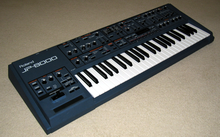Roland JP-8000: Difference between revisions
| Line 52: | Line 52: | ||
* [[Chicane (recording artist)|Chicane]] |
* [[Chicane (recording artist)|Chicane]] |
||
* [[Craig Jones]] |
* [[Craig Jones]] |
||
* [[Crescendo (band |
* [[Crescendo (band)|Crescendo]] |
||
* [[David Bowie]] |
* [[David Bowie]] |
||
* [[Depeche Mode]] |
* [[Depeche Mode]] |
||
Revision as of 22:14, 1 August 2010
This article needs additional citations for verification. (March 2010) |
| JP-8000 | |
|---|---|
 | |
| Manufacturer | Roland |
| Dates | 1997 - 2001 |
| Technical specifications | |
| Polyphony | 8 voices |
| Timbrality | 2 |
| Oscillator | 2 oscillators per voice / sync OSC1 types : Super wave / Triangle mod / noise / Feedback / Square / Saw / Triangle. OSC2 types : Square / Saw / Triangle |
| LFO | 2 sawtooth/square/triangle/sh |
| Synthesis type | Virtual analog Subtractive |
| Filter | 1 12dB / 24dB resonant lowpass/highpass/bandpass |
| Attenuator | 2 ADSR |
| Aftertouch expression | No |
| Velocity expression | Yes |
| Storage memory | 128 presets/128 user patches 64 preset performances/64 user performances |
| Effects | Chorus, delay, 2 band EQ / ring modulator |
| Input/output | |
| Keyboard | 49 keys |
| External control | MIDI |
The Roland JP-8000 is an analog modeling synthesizer released by the Roland Corporation in 1997.
Overview
The Roland JP-8000 was released in early 1997 to compete with the other analog modeling synthesizers of the period such as the Access Virus, Clavia Nord Lead the Korg MS2000 and the Yamaha AN1x. These were the early Virtual Analog Synthesizers (VA synths) that were released in the mid to late 1990's. While the functionality, sound, and architecture of the JP-8000 differs from these other synthesizers, it shared the same purpose of recreating the unique sound and functionality of classic analog synths. The JP-8000 was viewed at the time as the modern incarnation of the classic Roland Jupiter-8, from 1981. It sought to reproduce the warm tonalities and sheer analog power of its older, bigger brother, of course with a modern slant, adding all kinds of features, from motion control, to RPS, to the fabled Super Saw oscillators and old-school controllers such as an arpeggiator and an assingable touch response ribbon control.
The JP-8000 had several features that differed from other analog modeling synthesizers of the time. Most notably, Roland's unique oscillator types ("Feedback" and "Supersaw") and the use of sliders instead of rotary encoders (knobs) to edit patch parameters. The Supersaw in particular was the reason why the JP-8000 was particularly successful as a main keyboard (along with the Virus) in the dance music market, especially for Trance. Just like the TB-303 had done for Acid Techno, the JP-8000's Supersaw leads were characteristic of a certain type of Trance that can be roughly called "Anthem Trance", where a melodic, powerful lead based on a Supersaw patch provided the hook and melody throughout the song.
In 1998, Roland released a 6U,19" rack version of JP-8000 called the JP-8080. The JP-8080 combined the analog modeling sound engine of the JP-8000 with additional features such as an internal vocoder. Three times the amount of Patches and performances and an additional Noise waveform was available on Osc 2, which although most patches are compatible between the rack and the JP-8000, some were specifically designed for the rack version only. Also included on the JP-8080 was a distortion effect.
The Supersaw
The Supersaw is a special waveform originally created by Roland for their JP-8000 and JP-8080 line of analog modeling synthesizers. The idea behind the Supersaw is to emulate the sound of more than one sawtooth oscillator using just one oscillator. The waveform is described as a freerun oscillator and its shape is produced from 7 sawtooth oscillators detuned against each other over a period of time.
Since production of the JP-8000 ceased, several companies have incorporated "Supersaw-like" oscillator algorithms into their hardware and software synthesizers. SUPERWAVE P8 is an example of a software synthesizer inspired by the architecture of the JP-8000 with its multiple sawtooth oscillators, another one being Supersaw Plus [1] which has a JP-8000-style interface and a variation on the supersaw waveform allowing for 2, 4, 6 or 10 oscillators. In 2005 Access Music released their new TI-line of synthesizers which feature an oscillator typed called Hypersaw, which has similar functionality to Roland's Supersaw oscillator. Roland has also continued to produce other synthesizers such as the SH-201, the Roland V-Synth, and the Roland V-Synth XT that have the Supersaw as an available oscillator type.
The Supersaw gained much popularity in electronic dance music, specifically trance music.
References
Notes
Notable users
- Aron Magner from The Disco Biscuits
- Armin van Buuren
- Blondie (Maria)
- Brian Transeau
- Charly Garcia
- Chicane
- Craig Jones
- Crescendo
- David Bowie
- Depeche Mode
- Disco Biscuits
- Duran Duran
- Faithless (God Is a DJ strings)
- Ferry Corsten
- Front 242 (Feedback Osc)
- Garbage
- Gary Numan
- Gavin Castleton
- Geoff Downes
- Goldie
- Groove Armada
- The Hitmen (Trance)
- Jean Michel Jarre
- Kate Ryan
- Kate Ryan
- KMFDM
- Luke Terry
- Martin Butler
- Michael Pinnella
- Doll Factory
- Muse
- Paul Van Dyk
- Pet Shop Boys
- port-royal
- The Prodigy
- Robin Brandes (Rob Mayth)
- Rank 1 (Airwave main melody)
- Scooter
- Tangerine Dream
- The Adjective Noun
- The Automatic (Monster)
- The Crystal Method
- Tiesto
- 3 Steps Ahead
- Underworld
- Velvet Acid Christ
- Vince Clarke
- William Orbit
- Secrettes
External links
- Roland JP-8000 at Vintagesynth.com
- Roland JP-8000 JP8000 user comments at Dancetech.com
